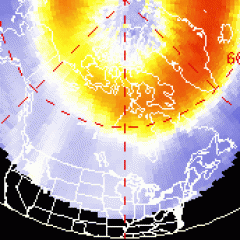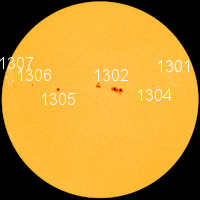Figured, why not...got every other kind of natural activity covered. ;-)
So this is the space discussion thread to cover space weather and the like. Some of the main sites out there to check out:
http://www.spaceweather.com/
http://www.space.com/
http://www.nasa.gov/home/index.html
http://esa-spaceweather.net/
http://neo.jpl.nasa.gov/neo/groups.html
http://neo.jpl.nasa.gov/index.html
Here are some images that will update automatically...
_____Current Auroral Oval __ _____ Latest Solar Surface Image ___

__Current Sunspot Map __ _______ Coronal Holes _____

Near Earth Object Information
Every now and then you'll hear about NEO's or asteroids getting too close for comfort. Each one is assigned a designated Torino Scale number based on their thread.
Currently Observed NEO's & Risk Assessment: http://neo.jpl.nasa.gov/risk/
No Hazard (White Zone)
0 - The likelihood of a collision is zero, or is so low as to be effectively zero. Also applies to small objects such as meteors and bodies that burn up in the atmosphere as well as infrequent meteorite falls that rarely cause damage.
Normal (Green Zone)
1 - A routine discovery in which a pass near the Earth is predicted that poses no unusual level of danger. Current calculations show the chance of collision is extremely unlikely with no cause for public attention or public concern. New telescopic observations very likely will lead to re-assignment to Level 0.
Meriting Attention by Astronomers (Yellow Zone)
2 - A discovery, which may become routine with expanded searches, of an object making a somewhat close but not highly unusual pass near the Earth. While meriting attention by astronomers, there is no cause for public attention or public concern as an actual collision is very unlikely. New telescopic observations very likely will lead to re-assignment to Level 0.
3 - A close encounter, meriting attention by astronomers. Current calculations give a 1% or greater chance of collision capable of localized destruction. Most likely, new telescopic observations will lead to re-assignment to Level 0. Attention by public and by public officials is merited if the encounter is less than a decade away.
4 - A close encounter, meriting attention by astronomers. Current calculations give a 1% or greater chance of collision capable of regional devastation. Most likely, new telescopic observations will lead to re-assignment to Level 0. Attention by public and by public officials is merited if the encounter is less than a decade away.
Threatening (Orange Zone)
5 - A close encounter posing a serious, but still uncertain threat of regional devastation. Critical attention by astronomers is needed to determine conclusively whether or not a collision will occur. If the encounter is less than a decade away, governmental contingency planning may be warranted.
6 - A close encounter by a large object posing a serious but still uncertain threat of a global catastrophe. Critical attention by astronomers is needed to determine conclusively whether or not a collision will occur. If the encounter is less than three decades away, governmental contingency planning may be warranted.
7 - A very close encounter by a large object, which if occurring this century, poses an unprecedented but still uncertain threat of a global catastrophe. For such a threat in this century, international contingency planning is warranted, especially to determine urgently and conclusively whether or not a collision will occur.
Certain Collisions (Red Zone)
8 - A collision is certain, capable of causing localized destruction for an impact over land or possibly a tsunami if close offshore. Such events occur on average between once per 50 years and once per several 1000 years.
9 - A collision is certain, capable of causing unprecedented regional devastation for a land impact or the threat of a major tsunami for an ocean impact. Such events occur on average between once per 10,000 years and once per 100,000 years.
10 - A collision is certain, capable of causing global climatic catastrophe that may threaten the future of civilization as we know it, whether impacting land or ocean. Such events occur on average once per 100,000 years, or less often.





 Reply With Quote
Reply With Quote






Bookmarks